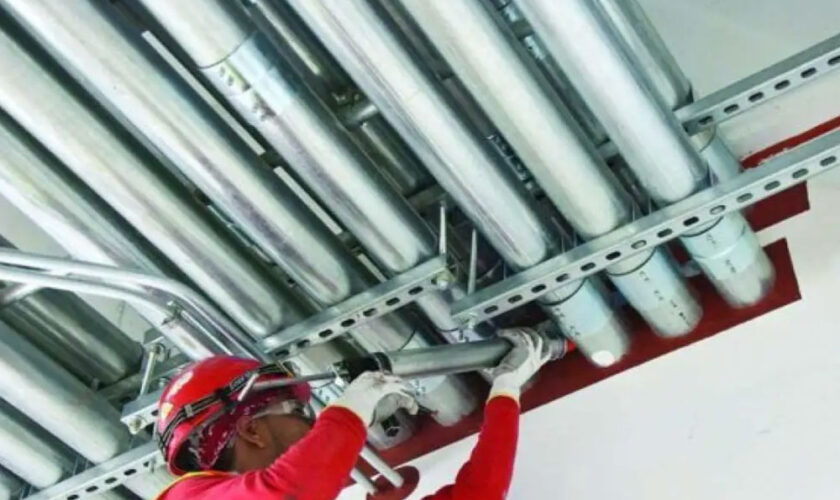A fire roaring through your building is something you worry about, and hope never happens. While every facility worker will do all possible to prevent a fire from starting in the first place, the next step is understanding how to limit its spread. Moreover, many individuals know the fundamentals of fire suppression (extinguishers, sprinklers, etc.). Still, passive fire protection that controls a fire at its source might be inconspicuous and practically forgotten once you genuinely appreciate and rely on it.
What Exactly Is Passive Fire Protection?
The phrase ‘passive fire protection’ refers to structural measures to reduce the danger of fire damage. This risk includes occupant safety and financial and reputational damages caused by building damage.
Moreover, passive fire protection systems mitigate fire damage in a variety of ways. Buildings are divided into manageable sections to restrict the passage of smoke and flames (also called compartmentation), and load-bearing structural components (e.g., beams, partitions, and columns) are reinforced to sustain fire damage for a prolonged period. This provides an important window of opportunity for a building to be safely evacuated.
What Areas Is PFP Concerned About?
The following areas are the main worries of passive fire protection:
1. Compartmentation
Partitioning includes fire barriers, smoke barriers, fire partitions, and firewalls. Fire-rated walls, ceilings, and walls (typically composed of concrete, combination masonry, gypsum, or wood) are examples of fire barriers. These barriers are designed to prevent a fire from spreading throughout the area and to enable for a safe exit. To safeguard people completely, walls are extended from a fire-rated floor to the ceiling above and continue into hidden compartments.
2. Opening Protection
Fire windows and doors are fitted in fire barrier openings to preserve fire resistance, since frames, hardware, and doors provide an efficient smoke and fire barrier. Fire-rated glazing or glass and frame are evaluated as a whole assembly to protect the fire barrier. Furthermore, fire and smoke dampers are regarded as “opening protection” and fill the fire barrier when air ducts gets into fire-rated and smoke-resistant components.
3. Structural Fire Protection
Structural fire protection protects critical structural components from the effects of fire, like the steel frame and joint systems. This is done by the use of a fireproofing items or the construction of the structure using concrete products. When structural fire protection is correctly planned and implemented, the structural integrity of the building should be preserved when it is exposed to fire.
4. Firestopping Materials
These materials are used to inhibit fire propagation via fire barrier penetrations. It is rare for a fire barrier to be breached during a simple building modification and for the penetrating object to be unprotected by fire stopping. For example, electricians, plumbers, and communications engineers may leave concealed gaps in the barriers as they work.
5. Cable Coating
Fire retardants or fire-rated cable coatings are applied to wires, sheaths, or cables to prevent fire spread and safeguard assets. Intumescent coating is one example. Fire doors, emergency exit lights, fire floors, firewalls, mortar coating, flame shields, intumescent paint, dampers, mineral fibre matting, and spray fireproofing are some examples.
The Passive Fire Protection Significance
Passive fire protection is vital to any contemporary structure or institution because it adds an additional layer of safety and security for people, property, and assets. It decreases the damage and danger to life, allows people more time to leave the building’s premises, and gives emergency services more time to react. Aside from the features of passive fire prevention systems, maintaining a safe atmosphere for your workers is already a must. And you may do it by using high-quality fire-retardant or fire-stopping materials.
Furthermore, safeguarding your assets from fire threats is the finest investment you can make – and this cannot be overstated. A passive fire protection system, whether for employee welfare or asset and property management, is a win-win scenario.
Maintaining Passive Fire Protection
Along with understanding the regulations and ratings for each PFP system in your building, regular and comprehensive maintenance is essential. Structure owners and managers of facilities are critical players in the fire-protection programme of a structure.
As such, they should be included at every stage of building modification to guarantee that life safety is not jeopardised. This encompasses building planning, layout, building, and upkeep. In addition, if a portion of your structure is plumbed or rewired, or if new communications systems are installed, there is a considerable risk that fire barriers have been breached.
The Effectiveness of Passive Fire Protection Measures
The fire prevention system in your building is only as good as the brand and personnel you choose to rely on. Not all things in the marketplace have undergone the same manufacturing and testing procedures, nor are they manufactured with the same materials and goals. And wasting your money, time, and other resources on inferior materials may do more damage than good.
Hence, you should choose passive fire protection solutions with thorough, demanding testing methods, valid certifications from international organisations, and quality evaluation think tanks. This way, you can be certain that you are receiving the most value for your dollar.
In Summary
Know what’s happening in your building, and keep an eye out for modifications in the fire-protection system that might compromise its effectiveness.
Reviewing your region’s compliance and industry standards is critical. Because various passive fire protection technologies need varying installation, application, and climatic circumstances, it is strongly advised to work with field specialists to determine which passive fire protection solutions are appropriate for your next project and how to use them effectively.

